‘Beautiful but terrible’: historic mountain towns buckle under weight of California snow | California
Blake Heauser’s chainsaw slowly rumbled quiet. Sounds of tall trees splintering and crashing under the weight of the freshly fallen snow cut through the stillness, as the latest round of winter weather bore down on the town, tucked into the foothills in northern California. He had cleared a path through the wooded debris for now but with more storms in the forecast it might not last.
Heauser had spent days trying to remove fallen trees from the roads that snaked through the hillsides in his community in Grass Valley, even as those roads disappeared under the heavy snow. He and others worked around the clock to ensure vulnerable neighbors could either evacuate or were able to safely remain in their buried homes, while grappling with the effects of prolonged and widespread power outages that left some without heat or pumped well water.
“This is the craziest storm I know of,” Heauser said. “It was relentless – it just kept snowing and snowing and snowing.”
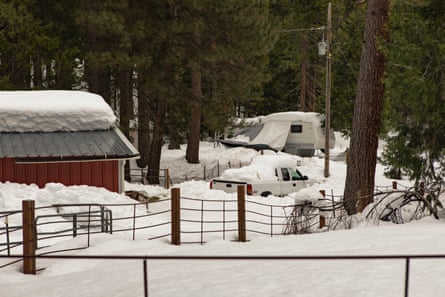
Tucked amid a sea of conifers that slope into the Sierra Nevada range, the beautiful and rugged terrain has always posed elements of danger for those who live there. But conditions are intensifying, adding new fears over what the future holds for California’s picturesque and historic mountain towns.
Even as locals grapple with the effects of this very wet winter, the threats from wildfires linger just months away. The extremes have tested key infrastructure across the seasons, adding hazards for even the most resilient and prepared residents. They are also inextricably linked.
Drought-weakened trees, unable to withstand the heavy snow loading their branches and the howling winds that tore through these slopes and canyons, thrashed against homes and fences. Branches ripped through power lines and littered thoroughfares before being buried in snow, hindering both emergency access and escape.
Severe storms have caused calamity across the state, coating even balmy parts of California – from the San Francisco Bay area to the Hollywood hills – in a dusting of white. Higher elevations, meanwhile, were buried.
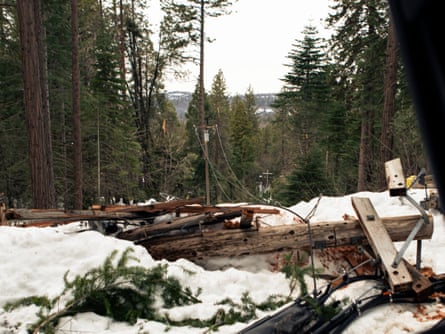
The toll is still being tallied as communities begin to dig out from the aftermath. Buildings have crumpled under the weight of accumulating snow and more than a dozen deaths from a snowed-in area of southern California may be linked to the storms.
Yosemite national park has announced it will remain closed through 17 March – a “best-case scenario” as a result of “significant snowfall” while the Central Sierra Snow Lab, housed against the Sierra near Donner Pass, reported more than 50 ft of snowfall already this season.
The San Bernardino county mountains were among the hardest hit, leaving residents and visitors trapped for weeks without the ability to secure food or emergency supplies as widespread power outages left neighborhoods dark and cold. At least five people were found dead in their homes as the snow-stricken area began to return to normal.
California Governor Gavin Newsom activated the state California guard and proclaimed a state of emergency in 13 counties to assist during the height of the storms. But the widespread effects choked off resources as impacted areas across the state called for more help.

Nevada county, which stretches from the lower lying areas north of Sacramento, over to Tahoe national forest and to the eastern edge of northern California, has borne the brunt of power outages for the past week, leaving thousands of households without light and heat for days while rain and snow continue to fill the forecast without reprieve.
Energy provider Pacific Gas & Electric has scrambled to repair downed poles and lines left scattered by the storms, but the lack of ability to get equipment into the rugged and frost-laden terrain has proven difficult and inhibited progress.
Meanwhile, dozens of displaced residents have sought refuge in overnight warming centers or in Nevada City’s historic hotels that typically house tourists during this time of year. All through last weekend as the snow fell in flurries, neighbors congregated in coffee shops swapping snow-shoveling stories and cold escapes from their mountainside homes. Many though, weren’t able to leave.
Record numbers of calls have come in to emergency response lines as desperate friends, relatives, and employers sought help for those who could not be reached for days.
“We have been to countless streets that have absolutely nothing left of their regular infrastructure,” said Conrad Ball, deputy sheriff with the Nevada county sheriff’s office mobile crisis team. Ball and his partner, social worker clinician Stacy Green, are one of several teams trying to get to each and every person flagged for welfare checks. But the list is long, and growing.
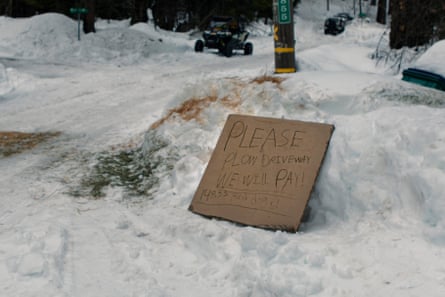
On a frigid Friday evening, the team spent more than 12 hours visiting residents, careening over narrow berms and chewed-through terrain. High in the hills, the smell of crisp pine is cut by wood smoke and gasoline, the remnants of last-resort heating in darkened neighborhoods. Mailboxes and trash cans have all but disappeared under thick mounds of snow as car-shaped lumps signal where vehicles have been abandoned. The occasional sign signals an obscured driveway, while others plead for plowing help.
There is 560 miles of roadway through these mountains, much of which is now buried in snow. Even an all-terrain vehicle slides and struggles to churn through the thick frost, bumping over the fallen power lines that snake across the roads.
Ball and Green have been able to assist dozens of families, either by ensuring loved ones are ready to weather the rest of the storm, providing essential supplies, or aiding in evacuations. Often though, Ball said, calamity was avoided because residents nearby were able to get there sooner. “That is a common thing with these storms,” he said. “Everyone sets their differences aside and really help each other out.” It’s essential part of life in these remote areas.
“If you don’t have others to help you out,” Ball added, “it is not survivable.”
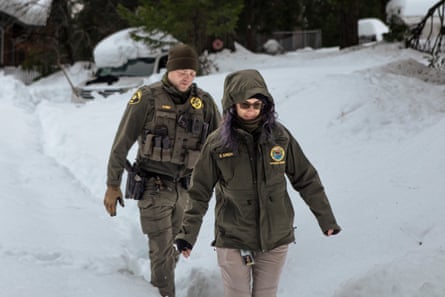
Stuart Baker, the executive director for the chamber of commerce in Nevada City, a historic district and tourist town that houses the seat of the county, said it’s not an uncommon sentiment. Even with strong assistance and support it’s not been easy.
Baker is one of many displaced by the storms, as snow piled high on his home covered vents that enabled him to use a furnace safely. His power has been out for a week. This isn’t the first time – but it is the worst, he said.
“We had snowmageddon and it felt like it was a once-in-a-century storm,” he said, referring to a previous weather event the community named after it blew through last year. “And it wasn’t as bad as this one. So we don’t have a word for this,” he added, laughing with a grimace. “We already used the best word we had.”
Nevada City resident Visa Uksina, who could only reach his home by snowshoes this week, agreed. “It is getting more and more intense,” he said, now safely out of his home and catching his breath in the more accessible downtown area where shops and restaurants provided warm refuge for those still without power. “It’s beautiful and terrible at the same time.”
It’s a feeling that hits hard for Heauser, too. Born and raised in this area, he returned with his wife to raise his own family in Nevada county. With a two-year-old daughter and another on the way, there’s a precarious balance between building a life on the land that feels like home and ensuring they stay safe as the threats mount.
As a corporate pilot who has to spend stretches of time away, he said he worries that his family will have to evacuate without him during the summers or lose power and heat in the winters. There’s only one way in and one way out, and “it is constantly in the back of your mind”, he said. But the storm has been enough of a distraction for now.
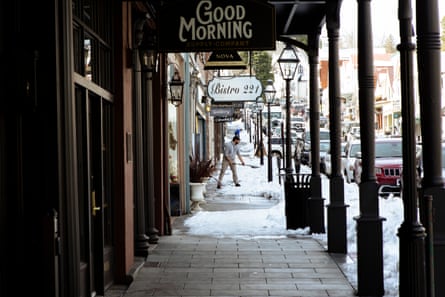
“It has all been a blur,” he said of the last week, when the family lost their power. Soon after, their generator shorted out, frying some electronics as it went down, including their hot water heater. With his toddler pitching tantrums, they retreated to his parent’s house nearby. Even there, toppling trees are a threat, already claiming a fence and a shed.
Heauser has spent most of the days since out in the elements helping others.
There was an older couple who were without power and heat and relied on oxygen machines. Some folks needed paths shoveled so they could leave their homes. And, Heauser of course has been out with his chainsaw, clearing the fallen trees. It’s been a team effort, he said.
“We have all been ping-ponging around and seeing where we can help,” Heauser said. “If we are tired they will tap in.” Along with the pristine natural beauty, that’s what keeps his family here, making the added worry worth it. For Heauser, it comes down to the people.
“If neighbors need a hand, we will dig ’em out,” he said. “Our neighborhood is situated well. As long as the trees quit falling – we will be OK.”